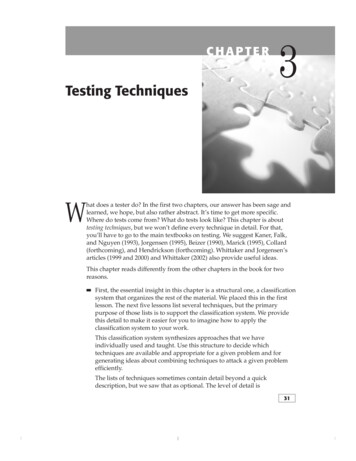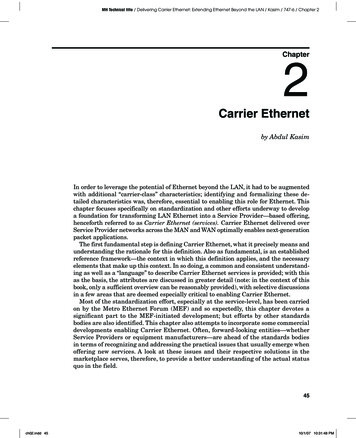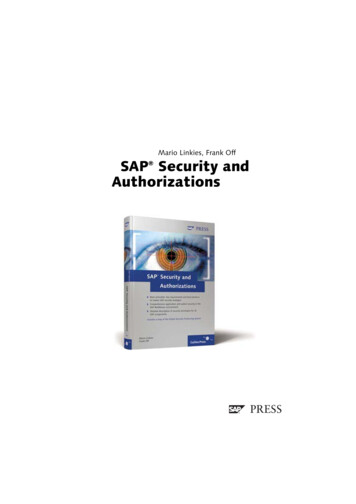
Transcription
71208 Kaner CH03I11/21/01 4:26 PMPage 31CHAPTERTesting Techniques3What does a tester do? In the first two chapters, our answer has been sage andlearned, we hope, but also rather abstract. It’s time to get more specific.Where do tests come from? What do tests look like? This chapter is abouttesting techniques, but we won’t define every technique in detail. For that,you’ll have to go to the main textbooks on testing. We suggest Kaner, Falk,and Nguyen (1993), Jorgensen (1995), Beizer (1990), Marick (1995), Collard(forthcoming), and Hendrickson (forthcoming). Whittaker and Jorgensen’sarticles (1999 and 2000) and Whittaker (2002) also provide useful ideas.This chapter reads differently from the other chapters in the book for tworeasons. First, the essential insight in this chapter is a structural one, a classificationsystem that organizes the rest of the material. We placed this in the firstlesson. The next five lessons list several techniques, but the primarypurpose of those lists is to support the classification system. We providethis detail to make it easier for you to imagine how to apply theclassification system to your work.This classification system synthesizes approaches that we haveindividually used and taught. Use this structure to decide whichtechniques are available and appropriate for a given problem and forgenerating ideas about combining techniques to attack a given problemefficiently.The lists of techniques sometimes contain detail beyond a quickdescription, but we saw that as optional. The level of detail is31
71208 Kaner CH03I3211/21/01 4:26 PMPage 32L E S S O N S L E A R N E D I N S O F T WA R E T E S T I N Gintentionally uneven. We expect that you’ll learn more about the details ofmost techniques in other books and classes. Lnesso48Second, even though this is not primarily a how-to chapter on techniques, wecouldn’t bring ourselves to write a chapter on testing techniques withoutdescribing at least a few techniques in enough detail that you could actuallyuse them. Hence the Addendum, which describes five techniques that we finduseful, in ways that have worked well for our students in professional-levelseminars and university courses on software testing.Testing combines techniques that focus ontesters, coverage, potential problems,activities, and evaluation.Our primary goal in this chapter is to present a classification system fortesting techniques. We call it the Five-fold Testing System. Any testing that youdo can be described in terms of five dimensions: Testers. Who does the testing. For example, user testing is focused ontesting by members of your target market, people who would normallyuse the product. Coverage. What gets tested. For example, in function testing, you test everyfunction. Potential problems. Why you’re testing (what risk you’re testing for). Forexample, testing for extreme value errors. Activities. How you test. For example: exploratory testing. Evaluation. How to tell whether the test passed or failed. For example,comparison to a known good result.We also describe a few techniques in detail in this chapter and presentinsights about the use of a few others, but our primary goal is to explain theclassification system.All testing involves all five dimensions. A testing technique focuses yourattention on one or a few dimensions, leaving the others open to yourjudgment. You can combine a technique that is focused on one dimensionwith techniques focused on the other dimensions to achieve the result youwant. You might call the result of such a combination a new technique (somepeople do), but we think the process of thinking is more useful than addinganother name to the ever-expanding list of inconsistently defined techniquesin use in our field. Our classification scheme can help you make thosecombinations consciously and thoughtfully.
71208 Kaner CH03I11/21/01 4:26 PMPage 33Chapter 3: Testing Techniques33Testing tasks are often assigned on one dimension, but you do the work in allfive dimensions. For example, Someone might ask you to do function testing (thoroughly test everyfunction). This tells you what to test. You still have to decide who does thetesting, what types of bugs you’re looking for, how to test each function,and how to decide whether the program passed or failed. Someone might ask you to do extreme-value testing (test for error handlingwhen you enter extreme values into a variable). This tells you what typesof problems to look for. You still have to decide who will do the testing,which variables to test, how to test them, and how you’ll evaluate theresults. Someone might ask you to do beta testing (have external representatives ofyour market test the software). This tells you who will test. You still haveto decide what to tell them (and how much to tell them) about, what partsof the product to look at, and what problems they should look for (andwhat problems they should ignore). In some beta tests, you might also tellthem specifically how to recognize certain types of problems, and youmight ask them to perform specific tests in specific ways. In other betatests, you might leave activities and evaluation up to them.Techniques don’t necessarily fit on only one dimension. Nor should they;all testing involves all five dimensions, and so we should expect thericher test techniques to span several. Here’s an example of what can be amultidimensional technique: If someone tells you to do “requirements-basedtesting,” she might be talking about any combination of three ideas: Coverage (Test everything listed in this requirements document.) Potential problems (Test for any way that this requirement might not be met.) Evaluation (Design your tests in a way that allows you to use therequirements specification to determine whether the program passed orfailed the test.)Different testers mean different combinations of these ideas when they say,“requirements-based testing.” There is no one right interpretation of this phrase.11The multiple meanings of requirements-based testing provide an example of an important general problem insoftware engineering. Definitions in our field are fluid. Usage varies widely across subcommunities andindividuals, even when documents exist that one might expect to see used as reference standards. We’llpostpone a discussion of the factors that we think lead many people to ignore the standards documents. Ourpoint here is to note that we’re not claiming to offer authoritative definitions or descriptions of the field’stechniques. Some other people will use the same words to mean different things. Others probably agree withthe sense of our description but would write it differently. Either position might be reasonable and defensible.
71208 Kaner CH03I3411/21/01 4:26 PMPage 34L E S S O N S L E A R N E D I N S O F T WA R E T E S T I N GDespite the ambiguities (and, to some degree, because of them), we find thisclassification system useful as an idea generator.By keeping all five dimensions in mind as you test, you might make betterchoices of combinations. As in beta testing, you may choose not to specifyone or more of the dimensions. You might choose to not decide how resultswill be evaluated or how the tester will do whatever she does. Oursuggestion, though, is that you make choices like that consciously, ratherthan adopting a technique that focuses on only one of these dimensionswithout realizing that the other choices still have to be made.Lnesso49People-based techniques focus on whodoes the testing.Here are some examples of common techniques that are distinguished bywho does them.User testing. Testing with the types of people who typically would use yourproduct. User testing might be done at any time during development, atyour site or at theirs, in carefully directed exercises or at the user’sdiscretion. Some types of user testing, such as task analyses, look more likejoint exploration (involving at least one user and at least one member ofyour company’s testing team) than like testing by one person.Alpha testing. In-house testing performed by the test team (and possiblyother interested, friendly insiders).Beta testing. A type of user testing that uses testers who aren’t part of yourorganization and who are members of your product’s target market. Theproduct under test is typically very close to completion. Many companiesthink of any release of prerelease code to customers as beta testing; theytime all beta tests to the milestone they call “beta.” This is a mistake. Thereare actually many different types of beta tests. A design beta, which asks theusers (especially subject matter experts) to appraise the design, should goout as soon as possible, in order to allow time for changes based on theresults. A marketing beta, intended to reassure large customers that theyshould buy this product when it becomes available and install it on theirlarge networks, should go out fairly late when the product is quite stable.In a compatibility test beta, the customer runs your product on a hardwareand software platform that you can’t easily test yourself. That must bedone before it’s too late for you to troubleshoot and fix compatibilityproblems. For any type of beta test that you manage, you should
71208 Kaner CH03I11/21/01 4:26 PMPage 35Chapter 3: Testing Techniques35determine its objectives before deciding how it will be scheduled andconducted.Bug bashes. In-house testing using secretaries, programmers, marketers, andanyone who is available. A typical bug-bash lasts a half-day and is donewhen the software is close to being ready to release. (Note: we’re listingthis technique as an example, not endorsing it. Some companies havefound it useful for various reasons; others have not.)Subject-matter expert testing. Give the product to an expert on some issuesaddressed by the software and request feedback (bugs, criticisms, andcompliments). The expert may or may not be someone you would expectto use the product—her value is her knowledge, not her representativenessof your market.Paired testing. Two testers work together to find bugs. Typically, they shareone computer and trade control of it while they test.Eat your own dogfood. Your company uses and relies on prerelease versionsof its own software, typically waiting until the software is reliable enoughfor real use before selling it.Lnesso50Coverage-based techniques focus on whatgets tested.You could class several of these techniques differently, as problem-focused,depending on what you have in mind when you use the technique. Forexample, feature integration testing is coverage-oriented if you use it to checkthat every function behaves well when used in combination with any otherfunction. It’s problem-oriented if you have a theory of error for functionsinteracting together and you want to track it down. (For example, it’sproblem oriented if your intent is to demonstrate errors in the ways thatfunctions pass data to each other.)We spend some extra space on domain testing in these definitions and at theend of the chapter because the domain-related techniques are so widely usedand so important in the field. You should know them.Function testing. Test every function, one by one. Test the functionthoroughly, to the extent that you can say with confidence that the functionworks. White box function testing is usually called unit testing andconcentrates on the functions as you see them in the code. Black boxfunction testing focuses on commands and features, things the user can do
71208 Kaner CH03I3611/21/01 4:26 PMPage 36L E S S O N S L E A R N E D I N S O F T WA R E T E S T I N Gor select. It’s wise to do function testing before doing more complex teststhat involve several functions. In a complex test, the first broken functionwill probably stop the test and block you from finding, with this test, thatseveral other functions are also broken. If you rely on complex tests insteadof testing the functions individually, you might not know until very latethat one function is broken, and you might spend an enormous amount ofwork troubleshooting the complex test, only to discover the problem wasin a simple function.Feature or function integration testing. Test several functions together, to seehow they work together.Menu tour. Walk through all of the menus and dialogs in a GUI product,taking every available choice.Domain testing. A domain is a (mathematical) set that includes all possiblevalues of a variable of a function. In domain testing, you identify thefunctions and the variables. The variables might be input or outputvariables. (The mathematical distinction between input domains andoutput ranges is not relevant here, because the testing analysis is the samefor both cases.) For each variable, you partition its set of possible valuesinto equivalence classes and pick a small number of representatives(typically boundary cases) from each class. The assumption of the methodis that if you test with a few excellent representatives of a class, you’ll findmost or all of the bugs that could be found by testing every member of theclass. Note that in contrast to function testing, the primary element ofinterest is the variable rather than the function. Many variables are used bymore than one function. The domain tester will analyze a variable andthen, based on that analysis, run tests that involve this variable on eachfunction with this variable as an input or an output.Equivalence class analysis. An equivalence class is a set of values for avariable that you consider equivalent. Test cases are equivalent if youbelieve that (a) they all test the same thing; (b) if one of them catches a bug,the others probably will too; and (c) if one of them doesn’t catch a bug, theothers probably won’t either. Once you’ve found an equivalence class, testonly one or two of its members.Boundary testing. An equivalence class is a set of values. If you can mapthem onto a number line, the boundary values are the smallest and largestmembers of the class. In
34 LESSONS LEARNED IN SOFTWARE TESTING L e s o n 49 Despite the ambiguities (and, to some degree, because of them), we find this classification system useful as an idea generator. By keeping all five dimensions in mind as you test, you might make better choices of combinations. As in beta testing, you may choose not to specify one or more of the dimensions. You might choose to not decide how











